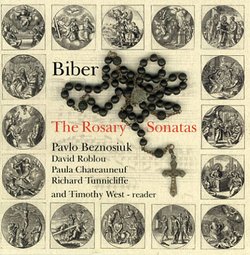| All Artists: Heinrich Ignaz Franz von Biber, Timothy West, David Roblou, Paula Chateauneuf, Pavlo Beznosiuk, Richard Tunnicliffe Title: Biber: The Rosary Sonatas Members Wishing: 0 Total Copies: 0 Label: Avie Original Release Date: 1/1/2004 Re-Release Date: 7/20/2004 Album Type: Import Genres: Special Interest, Classical Styles: Chamber Music, Historical Periods, Baroque (c.1600-1750), Classical (c.1770-1830), Instruments, Strings Number of Discs: 2 SwapaCD Credits: 2 UPC: 822252003826 |
Search - Heinrich Ignaz Franz von Biber, Timothy West, David Roblou :: Biber: The Rosary Sonatas
 | Heinrich Ignaz Franz von Biber, Timothy West, David Roblou Biber: The Rosary Sonatas Genres: Special Interest, Classical |
Larger Image |
CD DetailsSimilar CDs |
CD ReviewsAcross the centuries and media Czinczar | Southeast Michigan, USA | 05/01/2005 (4 out of 5 stars) "This is a production that incorporates audio techniques that span the centuries and combines muisic, the spoken word, literature and visual art. The result is a bit unusual, but mostly effective. Before each sonata is performed, a reading from a Rosary Psalter from the late Middle Ages is given by British actor Timothy West. He gives an imposing reading, sounding as if he were acting in a Shakespeare drama. You may enjoy this or be put off by it, depending on your tastes and mood. Frankly, the readings didn't interest me. But it's a small matter to program out the readings on your CD player if you want to. The readings do serve a useful purpose, though. The Psalter description of each Mystery, along with the poetic meditation it provides, gives us great insight into the programmatic depiction contained in Biber's corresponding sonata. Other things help, too. James Clements' liner notes description of the musical technique Biber used to portray each Mystery is very useful. In fact, without those verbal and literary descriptions, I would never have guessed what Biber was trying to portray. On their own, the sonatas just sound like nondescript pieces of absolute music. Lastly, the engraving illustrations included in the original music manuscript are shown on the album's cover. At least I assume these are the original illustrations. The liner notes don't specifically say so. These illustrations are an additional aid for us to appreciate and understand the music. Biber wrote these sonatas in a style with much gusto and frequently called for great virtuosity. Fortunately, Beznosiuk is up to the task. His performance of the Guardian Angel passacaglia really shines. His talent handles the music well, but in the effort to execute this tricky music, he ends up giving the music a modern feel instead of the needed Baroque feel. Biber calls for a different violin tuning with each sonata, which keeps things interesting. The instruments used by all the musicians are either period instruments or modern reproductions of period instruments. Yet, all the instruments sound modern! Maybe it's just my own perception. One odd thing about the recording is the acoustics involved. It was recorded in St. Andrew's Church, Toddington, Gloucestershire. Apparently it's an old church. The reverb during the reading is almost distractingly strong. It's a very different story with the instruments, though. Here, in the same church, I hear no reverb or any sense of acoustical space. It may as well have been done in a modern recording studio. The continuo instruments come through clearly and prominently. Certainly not the Baroque sound we're used to. They intrude a bit on the solo violin's aural space. Some bad mixing on the engineers' part. This production certainly stands apart among recordings of the Biber sonatas. The techniques involved may or may not appeal to you. Overall, I think it's an adventurous, change-of-pace rendition. All things considered, I would recommend it to you." A Wonderful and Moving Recording John A. Zack III | 09/15/2008 (5 out of 5 stars) "I am very pleased with this offering. The recording and performances are superb and the meditations preceding the sonatas add a great depth of understanding as they are typical of the period in which the sonatas were composed. My only criticism of the album is that the narrator of the meditations is hard to hear owing to the accoustics under which the meditations were recorded."
|


